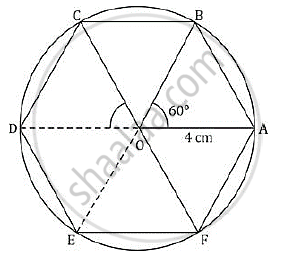Advertisements
Advertisements
प्रश्न
Construct a regular hexagon of side 4 cm. Construct a circle circumscribing the hexagon.
उत्तर

Steps of construction:
- Draw a circle of radius 4 cm with centre O.
- Since the interior angle of regular hexagon is 60°, draw radii OA and OB such that ∠AOB = 60°.
- Cut off arcs BC, CD, EF and each equal to arc AB on given circle.
- Join AB, BC, CD, DE, EF, FA to get required regular hexagon ABCDEF in a given circle.
The circle is the required circumcircle, circumscribing the hexagon.
APPEARS IN
संबंधित प्रश्न
Using a ruler and a compass, construct a triangle ABC in which AB = 7 cm, ∠CAB = 60° and AC = 5 cm. Construct the locus of :
- points equidistant from AB and AC.
- points equidistant from BA and BC.
Hence construct a circle touching the three sides of the triangle internally.
Using a ruler and compasses only:
1) Construct a triangle ABC with the following data: AB = 3.5 cm, BC = 6 cm and ABC = 120°
2) In the same diagram, draw a circle with BC as diameter. Find a point P on the circumference of the circle which is equidistant from AB and BC.
3) Measure ∠BCP.
Using ruler and compasses only,
- Construct triangle ABC, having given BC = 7 cm, AB – AC = 1 cm and ∠ABC = 45°.
- Inscribe a circle in the ΔABC constructed in (i) above. Measure its radius.
Using ruler and compasses only,
- Construct a triangle ABC with the following data :
Base AB = 6 cm, BC = 6.2 cm and ∠CAB = 60°. - In the same diagram, draw a circle which passes through the points A, B and C and mark its center O.
- Draw a perpendicular from O to AB which meets AB in D.
- Prove that : AD = BD.
Perpendicular bisectors of the sides AB and AC of a triangle ABC meet at O.
- What do you call the point O?
- What is the relation between the distances OA, OB and OC?
- Does the perpendicular bisector of BC pass through O?
Using ruler and compasses only, construct Δ ABC in which BC=7.5 cm, ∠ ABC = 60° and AC - AB= 1.5 cm. Inscribe a circle in the Δ ABC and measure its radius.
Draw a circle with radius 3 cm and inscribe an equilateral triangle in it.
In triangle ABC, ∠ABC = 90°, AB = 6 cm, BC = 7.2 cm and BD is perpendicular to side AC. Draw circumcircle of triangle BDC and then state the length of the radius of this circumcircle drawn.
Using ruler and compass only, construct a triangle ABC such that AB = 5 cm, ABC = 75°, and the radius of the circumcircle of triangle ABC is 3.5 cm. On the same diagram, construct a circle, touching AB at its middle point and also touching the side AC.
Ruler and compasses only may be used in this question. All constructions lines and arcs must be clearly shown, and the be sufficient length and clarity to permit assessment:
(i) Construct a triangle ABC, in which AB = 9 cm, BC = 10 cm and angle ABC = 45°.
(ii) Draw a circle, with center A and radius 2.5 cm. Let it meet AB at D.
(iii) Construct a circle to touch the circle with center A externally at D and also to touch the line BC.
